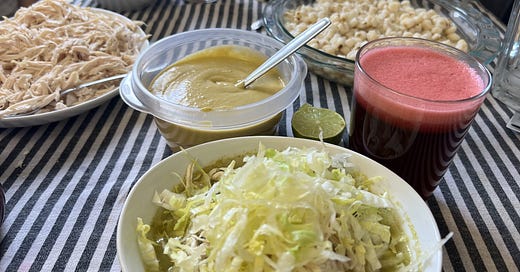History
Pozole is a traditional soup or stew deeply rooted in Mexican cuisine. It consists of hominy and meat, complemented by a variety of seasonings and garnishes such as shredded lettuce or cabbage, chili peppers, onion, garlic, radishes, avocado, salsa, or lime.
The term "pozole" originates from the Nahuatl language, specifically from the word "pozolli," derived from "tlapozonalli," meaning sparkling. This flavorful dish is prepared by simmering cacahuazintle corn grains, which are pre-cooked for two hours. During this process, the corn grains shed their fibrous shells, and when boiled, they open like flowers, creating a distinctive foamy appearance in the dish.
Pozole has been enjoyed since pre-conquest times, with historical records suggesting that even Emperor Moctezuma relished a serving of Pozole as an offering to the god Xipe Tótec, the deity associated with fertility, corn regeneration, and war.
Following the conquest, Spanish friars diligently collected numerous cooking recipes, and Pozole managed to transcend time, becoming a culinary delicacy, particularly during holidays. However, there is never a wrong time to savor this delicious dish.
Pozole is prepared in various ways, with regional differences influencing the cooking methods. Here are some examples:
1. White Pozole: This variation is the most popular and is made using dried cacahuazintle corn and parts of the pig's head. It is seasoned with lemon juice, salt, hot sauce, or ground chili, and garnished with lettuce, sliced radishes, chopped onion, and ground oregano.
2. Red Pozole: Originating from the state of Jalisco, this type of Pozole is prepared with ancho chili and guajillo chili. While it is commonly enjoyed with pork, some individuals prefer chicken or turkey as the protein component.
3. Green Pozole: Hailing from the state of Guerrero, Green Pozole is crafted using green tomatoes. In some variations, pork rinds and avocado are added to enhance the flavors and textures.
4. Pozole with Seafood: This variation is popular along the coasts of Colima, Jalisco, and Nayarit, although it is also savored in other states. The key ingredient is shrimp broth, prepared by combining lard with shrimp, fish, octopus, and clam callus. The resulting seafood-infused broth elevates the taste and aroma.
5. Vegetarian Pozole: For those who adhere to a vegetarian lifestyle, there is a delightful Pozole recipe that replaces the traditional pig's head with mushrooms. The broth is prepared using bay leaves, garlic, onion, guajillo chili, and mushrooms, resulting in a flavorsome vegetarian alternative.
Regardless of the preferred type of Pozole, it remains a dish that celebrates the rich bounty of the Mexican countryside. Its consumption surges in September, aligning with national festivities, making it a prominent feature on dining tables across the country.
Recipe
Now, let's move on to the recipe:
Ingredients:
- 1 can of precooked corn (approximately 6 lb.)
- 2 lbs. of chicken breast
- 15 green tomatoes
- 1/4 fresh lettuce
- 1 sprig of coriander
- 1/4 onion
- 4 cloves of fresh garlic
- 1 tbsp of chicken flavoring (I use Knorr)
- Onion, chopped into small squares
- Thinly sliced radishes
- Lemons
- Chopped lettuce
- Oregano
- Avocado, thinly sliced
- Hot sauce, to taste
- Toasts, for accompanying
Procedure:
1. In a medium pot, cook the chicken. Once it reaches a boil, allow it to simmer until fully cooked, which typically takes around 15-20 minutes.
2. Remove the cooked chicken from the broth and shred it. Add the corn to the same broth from which the chicken was removed.
3. Set the shredded chicken aside.
4. Blend the green tomatoes, onion, garlic, chicken flavoring, lettuce, and cilantro until smooth.
5. Add the blended mixture to the chicken broth with corn and cook for an additional 30 minutes.
6. Serve the corn base with green sauce on a deep plate and add the shredded chicken, lettuce, radishes, avocado slices, oregano, lemon juice, and hot sauce according to your taste preferences.
7. Accompany the dish with tostadas!
Some people enjoy pozole with sour cream and various sauces. One common sauce is made from arbol chili and peanuts. Let me know if you would like me to provide you with the recipe I use.
Recently, I prepared pozole for lunch on Sunday, and it reminded me that "there is deep history in each dish," as mentioned in the article we read earlier. I hope you also have the opportunity to prepare and savor this delightful dish.
Feel free to share photos of your pozole on my social media channels if you decide to give it a try!
IG: @gabrielagmontes
Twitter: @gabrielaimontes
Have an excellent week!
Sources:





